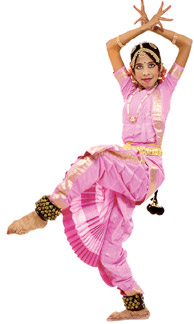Stage decor then and now
Subashini PATHMANATHAN
The stage decoration plays an important role. The modern stages
consists of public halls, which are rented for dance recitals. The
structure, the type of halls and the shape of the dais of the stage,
length, and level of height, of the stage, all verifying from one hall
to another. There is no standard size in the dais size for the dance
halls today. But in olden days, the dance drama halls were very well
structured according to a particular plan. For instance, ancient
Sanskrit drama halls were called Koothampalam. This drama stage was
planned and structured scientifically.
 The modern dance stages are decorated with readymade cutouts,
hardboard pillars with beautiful paintings and brass lamps. Natural and
artificial flowers are used for decorations. Selection of decoration is
according to the tastes, and financial status of the artistes. Sometimes
over-decorations distract the real performances. Previous selection of
the land, construction, and structure of the stage, the shape, and the
measurements were well defined in the Sastras. But with the passage of
time, all types of halls are selected according to the availability and
convenience of artistes. The modern dance stages are decorated with readymade cutouts,
hardboard pillars with beautiful paintings and brass lamps. Natural and
artificial flowers are used for decorations. Selection of decoration is
according to the tastes, and financial status of the artistes. Sometimes
over-decorations distract the real performances. Previous selection of
the land, construction, and structure of the stage, the shape, and the
measurements were well defined in the Sastras. But with the passage of
time, all types of halls are selected according to the availability and
convenience of artistes.
Varieties of stage
The ancient epic Silapathykaram clearly defines the construction of
stage and stage decoration. According to Natya Sastra, Viswakarma
designed three stages. These three varieties banked on three different
shapes of the stage. One was the square shape (chathura), other a
rectangular shape (vikrushta), and the nother was the triangular shape
(tryashra). Further these three shapes were divided into three different
sizes: small, medium and large.
The theatre structure was divided into three different sections. One
was the auditorium where the audience used to sit and watch the show.
The other was the greenroom.
The green room was at the back of the stage, where the characters
dress up and enter the stage. The green room was named Nepathyagraha in
olden days. Between the auditorium and the greenroom, the stage
structure was constructed. The same is still followed in all types of
stage constructions all over the world.
The green room was structured to have one door at the back of the
room for the characters to enter the greenroom. Further the greenroom
had two doors to enter and leave the stage. This type of structure was
possible only for the square and rectangular type of auditorium of those
days.
In the earlier days the central portion of the back stage was raised
up for the accompaniments (the supportive orchestra for the
performances).
These arrangements provided an opportunity for the audience to have a
proper view.
The raised portion of the back stage was called Rangasheersha. Today
the accompaniments sit at the right side of the stage (thatís why it is
called Pakka Vathiyam, sidement).
The stage was supported by pillars at each corner. Each pillar was
compared to four different castes which existed in those times. The
dancing or acting area was called Ranga Pitha.
The two sides of the stage were called Matavaaranees which were
supported by eight pillars.
Ancient traditions
In the Koothampalam (Sanskrit drama stage) also like the ancient
dance auditorium had small window to hear the sound clearly without much
vibration or echo.
In ancient dance stages beautiful designs were drawn including
elephants, birds, snakes and beautiful creepers. Such drawings can be
seen even today in the stage decoration cutouts.
Even in the Koothampala stages as well as the stages described in
Natya Sastra clearly indicate the seating arrangements of the audience.
Each row was raised above the previous row. It provides an
opportunity for the viewers to have a proper view.
Even today this aspect can be seen in all public auditoriums.
In ancient times the people hold the curtains, but today varieties of
dance curtains are used. Some are from one side to other, some are from
both sides join together.
These curtains are operated manually as well as mechanically.
Today science and technology are used to the maximum, in lightings
and sound system of the modern stages.
|



